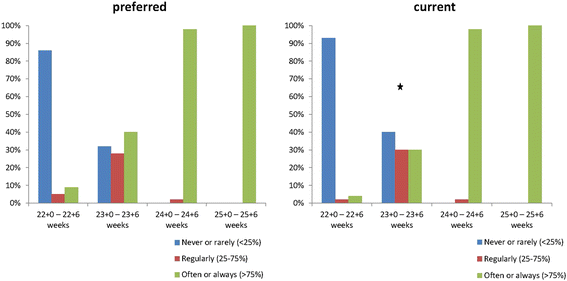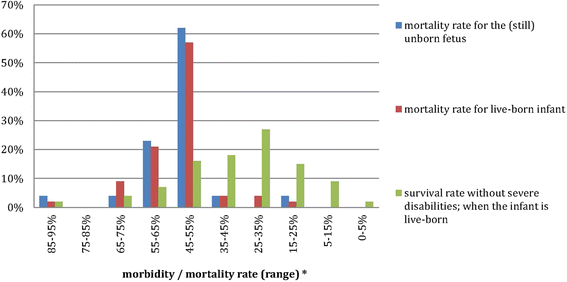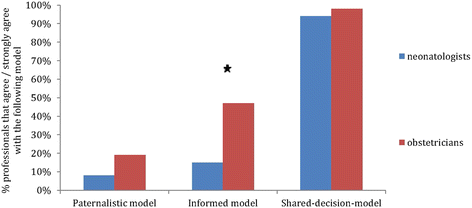Preferred prenatal counselling at the limits of viability: a survey among Dutch perinatal professionals
- PMID: 29298669
- PMCID: PMC5751814
- DOI: 10.1186/s12884-017-1644-6
Preferred prenatal counselling at the limits of viability: a survey among Dutch perinatal professionals
Erratum in
-
Correction to: Preferred prenatal counselling at the limits of viability: a survey among Dutch perinatal professionals.BMC Pregnancy Childbirth. 2018 Feb 19;18(1):54. doi: 10.1186/s12884-018-1680-x. BMC Pregnancy Childbirth. 2018. PMID: 29458341 Free PMC article.
Abstract
Background: Since 2010, intensive care can be offered in the Netherlands at 24+0 weeks gestation (with parental consent) but the Dutch guideline lacks recommendations on organization, content and preferred decision-making of the counselling. Our aim is to explore preferred prenatal counselling at the limits of viability by Dutch perinatal professionals and compare this to current care.
Methods: Online nationwide survey as part of the PreCo study (2013) amongst obstetricians and neonatologists in all Dutch level III perinatal care centers (n = 205).The survey regarded prenatal counselling at the limits of viability and focused on the domains of organization, content and decision-making in both current and preferred practice.
Results: One hundred twenty-two surveys were returned out of 205 eligible professionals (response rate 60%). Organization-wise: more than 80% of all professionals preferred (but currently missed) having protocols for several aspects of counselling, joint counselling by both neonatologist and obstetrician, and the use of supportive materials. Most professionals preferred using national or local data (70%) on outcome statistics for the counselling content, in contrast to the international statistics currently used (74%). Current decisions on initiation care were mostly made together (in 99% parents and doctor). This shared decision model was preferred by 95% of the professionals.
Conclusions: Dutch perinatal professionals would prefer more protocolized counselling, joint counselling, supportive material and local outcome statistics. Further studies on both barriers to perform adequate counselling, as well as on Dutch outcome statistics and parents' opinions are needed in order to develop a national framework.
Trial registration: Clinicaltrials.gov, NCT02782650 , retrospectively registered May 2016.
Keywords: (extreme) prematurity; (limits of) viability; Counselling; Decision-making.
Conflict of interest statement
Ethics approval and consent to participate
This study was exempt from IRB approval because of the survey-methodology examining only professionals, this was confirmed by the IRB (CMO region Arnhem – Nijmegen, file number 2015-1998).
Consent for Publication
Not applicable.
Competing interests
All authors declare that they have no competing interest.
Publisher’s Note
Springer Nature remains neutral with regard to jurisdictional claims in published maps and institutional affiliations.
Figures



Similar articles
-
Various experiences and preferences of Dutch parents in prenatal counseling in extreme prematurity.Patient Educ Couns. 2018 Dec;101(12):2179-2185. doi: 10.1016/j.pec.2018.07.003. Epub 2018 Jul 4. Patient Educ Couns. 2018. PMID: 30029812
-
Perinatal practice in extreme premature delivery: variation in Dutch physicians' preferences despite guideline.Eur J Pediatr. 2016 Aug;175(8):1039-46. doi: 10.1007/s00431-016-2741-7. Epub 2016 Jun 1. Eur J Pediatr. 2016. PMID: 27251669 Free PMC article.
-
Professionals' preferences in prenatal counseling at the limits of viability: a nationwide qualitative Dutch study.Eur J Pediatr. 2017 Aug;176(8):1107-1119. doi: 10.1007/s00431-017-2952-6. Epub 2017 Jul 7. Eur J Pediatr. 2017. PMID: 28687856 Free PMC article.
-
Perinatal care at the limit of viability between 22 and 26 completed weeks of gestation in Switzerland. 2011 revision of the Swiss recommendations.Swiss Med Wkly. 2011 Oct 18;141:w13280. doi: 10.4414/smw.2011.13280. eCollection 2011. Swiss Med Wkly. 2011. PMID: 22009720 Review.
-
Factors influencing the care provided for periviable babies in Australia: a narrative review.Reprod Health. 2015 Nov 25;12:108. doi: 10.1186/s12978-015-0094-8. Reprod Health. 2015. PMID: 26608822 Free PMC article. Review.
Cited by
-
Neonatal Resuscitation Practices in Romania: A Survey of the Romanian Association of Neonatology (ANR) and the Union of European Neonatal and Perinatal Societies (UENPS).J Crit Care Med (Targu Mures). 2024 Jan 30;10(1):19-29. doi: 10.2478/jccm-2024-0010. eCollection 2024 Jan. J Crit Care Med (Targu Mures). 2024. PMID: 39108797 Free PMC article.
-
Development of a checklist for evaluation of shared decision-making in consultation for extremely preterm delivery.J Perinatol. 2025 Jun;45(6):732-738. doi: 10.1038/s41372-024-02136-6. Epub 2024 Oct 22. J Perinatol. 2025. PMID: 39438609 Free PMC article.
-
Neonatologists' decision-making for resuscitation and non-resuscitation of extremely preterm infants: ethical principles, challenges, and strategies-a qualitative study.BMC Med Ethics. 2021 Sep 25;22(1):129. doi: 10.1186/s12910-021-00702-7. BMC Med Ethics. 2021. PMID: 34563198 Free PMC article.
-
Correction to: Preferred prenatal counselling at the limits of viability: a survey among Dutch perinatal professionals.BMC Pregnancy Childbirth. 2018 Feb 19;18(1):54. doi: 10.1186/s12884-018-1680-x. BMC Pregnancy Childbirth. 2018. PMID: 29458341 Free PMC article.
-
Digital decision aid for prenatal counseling in imminent extreme premature labor: development and pilot testing.BMC Med Inform Decis Mak. 2022 Jan 6;22(1):7. doi: 10.1186/s12911-021-01735-z. BMC Med Inform Decis Mak. 2022. PMID: 34991580 Free PMC article.
References
MeSH terms
Associated data
LinkOut - more resources
Full Text Sources
Other Literature Sources
Medical

